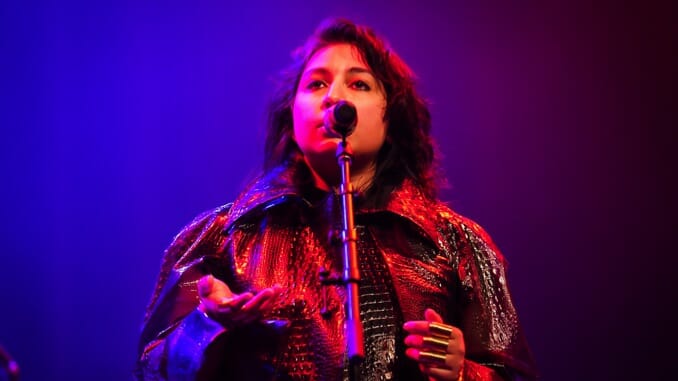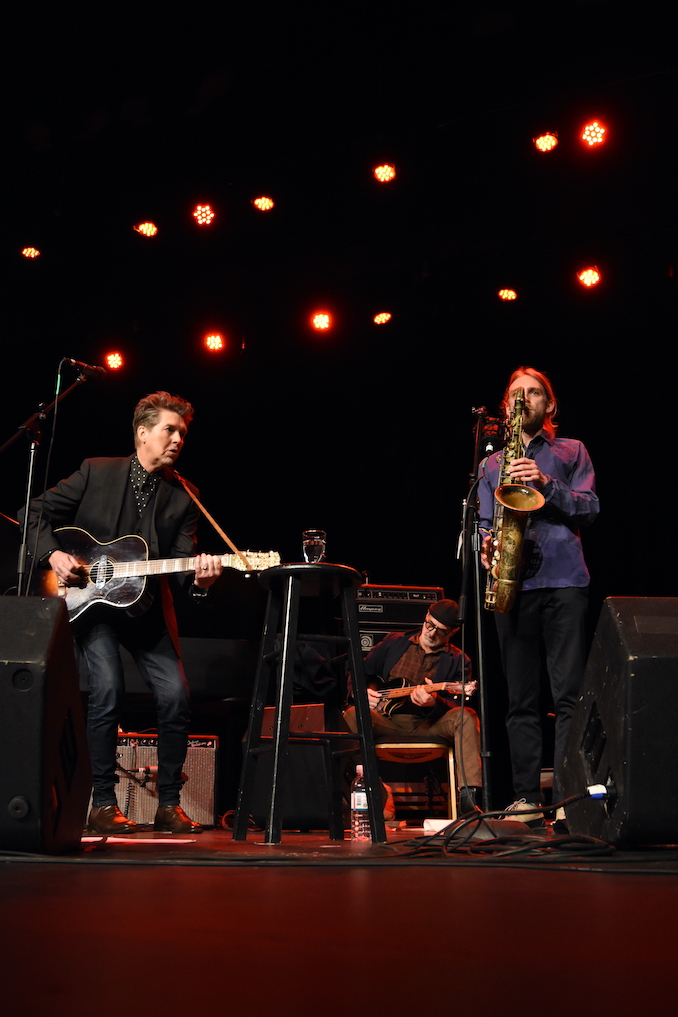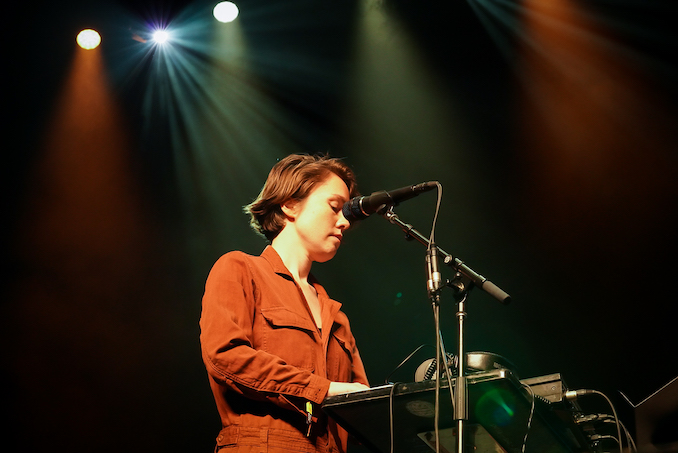Big Ears Festival Uplifts Musicians Pushing Past the Ordinary
Photo by Billie Wheeler, courtesy of the Big Ears Festival
On the third Saturday in March, Jason Moran was prowling the stage of Knoxville’s Bijou Theatre with restless energy. Wearing a gold-flecked black tracksuit, he paced back and forth with his head hung down as he explained his state of mind to the audience. The 47-year-old pianist, perhaps the best jazz artist of his generation, was lamenting the disappearance of the “night” in New York City, where he now lives; in Houston, where he grew up; and in cities across America.
He wasn’t suggesting, of course, that the sun had stopped setting and had begun burning 24 hours a day. He was referring to the “night” as that ultimate urban experience when people gather for food and drink, music and theater, conversation and creativity. That “night” had gone away during the pandemic, and it wasn’t clear if or how it would come back. He longed for it, he said, not only because that was how he made his living, but also because that was what made his life worth living.
He was afraid it would come back as a corporate facsimile of what it had once been, a commodified version of comestibles and culture, a predictable product with “easy endings.” He didn’t want that; he wanted a music, an artistic dialogue where anything might happen. For that, he needed collaborators and audiences with “big ears” who were willing to go on a journey without a predetermined destination.
This was clearly a reference to the Big Ears Festival going on around him that weekend, the annual, late-March event that brings the vanguards of jazz, classical music and pop music to Knoxville for four days of interactions and juxtapositions. From jazz improvisers such as Moran and Bill Frisell to string quartets such as Kronos and Attaca to pop singers such as Arooj Aftab and Joe Henry, the festival spotlighted the commonalities among musicians reaching beyond what’s already been done.
When Moran sat back down at his Steinway piano, he demonstrated that the newness he was looking for wasn’t dependent on new technology. That’s a common mistake for artists and audiences alike: the belief that new sounds require new machines. As Moran played “Toni Morrison Said Black Is a Rainbow (Shadow),” a recent piano composition, he proved that the old wood-wire-and-ivory contraption was still capable of gratifying surprises.
Even with no other musicians on stage, Moran conjured up stormy clouds of thickened chords shot through with rays of single-note melodies. Even though it was an instrumental, the piece reflected the struggle between anger and joy that’s life in America. The boundary-pushing of Morrison’s prose fiction was furthered by Moran’s jazz improvisation.
Moran’s set raised crucial questions about the avant-garde in the arts. It’s easy to confuse mere novelty with important new modes of expression, mere weirdness with pivotal innovation. The real vanguard is not the new stimuli created for our jaded palettes but rather the new challenges to our unexamined assumptions. What really matters is not hearing new sounds or seeing new images; what matters is encountering new juxtapositions of sounds and images that reflect our own unresolved conflicts.
One might ask, “Why do we even need new approaches to art? The conflicts in human nature are timeless, so why shouldn’t art be the same?” That’s a valid point, but while human nature is constant, the human environment is not, and we in the audience need representations of that context that change as constantly as our surroundings. And the central paradoxes of our lives—the tension between creation and destruction, between hope and loss—are never fully resolved, and we can always use new approaches to the same old problems.
Every year, the Big Ears Festival provides a useful arena for reconsidering these issues. Over four days in 15 venues clustered in downtown Knoxville, the event showcases jazz, classical and pop musicians in different combinations. Every venue is less than a mile away from any other venue, and stores, bars and restaurants are studded in between, so the environment is a real, walkable city, not a pasture out in the boondocks.
Moran, for example, performed three times during the festival: once in the solo-piano recital described above, once in a band led by Americana singer/songwriter Joe Henry, and once with the Bill Frisell Trio in a tribute to “The Music of Ron Miles.” Miles was a trumpeter and composer who had died just a few weeks before the festival. He was as beloved inside the jazz community as he was underappreciated by the general public, and Moran, guitarist Frisell, bassist Thomas Morgan and drummer Brian Blade played these knotty but pleasurable compositions with obvious emotion. At the end of the show, Blade led the Bijou in a chant of “Ron Miles! Ron Miles!”
Miles was also acknowledged by Myra Melford & Snowy Egret, the jazz combo in which he had played cornet for 10 years. Melford started her show at The Standard with a heartfelt tribute to Miles, and then led her revamped quartet (with the gifted trumpeter Cuong Vu replacing Miles) through a bracing set of the pianist/leader’s compositions. Though Melford is as white-topped and slender as the band’s namesake, she is as bruising in her keyboard attack and as lyrical in her sensibility as any bandleader in jazz today.
Joe Henry’s 115th Dream, a band named after the song “Bob Dylan’s 115th Dream,” was led by the acclaimed producer and included not only Moran, but also jazz guitarist Marc Ribot, the famed L.A. session duo of drummer Jay Bellerose and bassist David Piltch, and saxophonist Levon Henry, the leader’s son. The father’s songwriting is better at crafting great lines than great songs, but never had those songs sounded so good as they did with this Joni Mitchell-like jazz-rock band.
Photo by Eric Smith, courtesy of the Big Ears Festival
The most intriguing pop musician at the festival was Arooj Aftab, a Pakistani-American woman who is trying to collapse that hyphenated description through both her singing and her songwriting. Her 2021 album, Vulture Prince, landed on a lot of year-end, 10-best lists, and made her the first Pakistani Grammy winner, but her future seems even more exciting than her past.
At Big Ears, she performed at the Tennessee Theatre, a 1928 movie palace that has been restored to its dazzling dream of an imaginary Mediterranean palace. Aftab was joined by a multi-disciplinary band that included drummer Gyan Riley (son of classical composer Terry Riley), funk bassist Shahzad Ismaily, jazz violinist Darian Donovan Thomas and Celtic harpist Maeve Gilchrist. Over this fountain of different influences, Aftab sang in long-sustained vowels in the trance tradition of Pakistan’s ghazal poetry and Sufi devotional music. This was mesmerizing, but the highlight of the evening was the song “Last Night,” which boasted the clear influence of Billie Holiday. One can only hope that Aftab will continue to explore that avenue.
Aftab’s remarkable ability to maintain her robust vowels across many pitches, rhythms and measures was shared by a new generation of classical singers at the festival. This take on the art song is a welcome departure from the 1990s, when most composers asked vocalists to leap back and forth across large intervals in ping-pong-game fashion, thus destroying the notion the singer was mimicking actual human conversation. That may have delighted the academic theorists, but it didn’t do much for civilian audiences. These new singers take their cue instead from such minimalists as Philip Glass and Steve Reich to stretch patient phrases over expanding and shrinking rhythmic units.
Most notable of these vocalists was Caroline Shaw, who performed with So Percussion at the Tennessee Theatre to recreate their 2021 collaborative album, Let the Soil Play Its Simple Part. The four backing musicians (who nodded to Glass and Reich in their own set) created pulsing beats on marimbas, vibraphones, hand drums, drum kits and laptops as Shaw traced long arcs above.
Photo by Billie Wheeler, courtesy of the Big Ears Festival
Her soprano was more enchanting than overpowering, but it created an atmosphere of spells cast and secrets shared. In addition to her own lyrics—often aphorisms hypnotically repeated—with texts taken from old hymns, contemporary poets and James Joyce. As Shaw’s mantra-like vocals converged and diverged from the chattering percussion, the music became increasingly absorbing.
The godmother of this sort of art song is Meredith Monk, the doyenne of New York’s Downtown Music scene since the 1970s. She pioneered new vocal techniques, but her use of animal sounds, minimalist repetition and humor made her very different from the academics who dominated art song in the late 20th century. But while the theorists have faded from memory, she has become a legend, winner of many awards and featured in many films. She celebrated that long career with a big concert at the Tennessee Theatre, where she was joined by three singers (including jazz star Theo Bleckmann) and six instrumentalists from the Bang on a Can Allstars.
The first two thirds of her set were devoted to her 1984 work, The Games, a kind of sci-fi opera about refugees from Earth on a far-off planet who use annual rituals to remember their former home. Monk herself, a short woman with two very long braids down the back of a crimson satin suit, shared the vocals with two longtime female partners and Bleckmann over the chamber-music sextet. Often, short verbal phrases were repeated over and over with slightly different music to create the wanted otherworldly ambience.
Another soprano pursuing this kind of minimalist art song is Eliza Bagg (aka Lisel), who sang with Ellis Ludwig-Leone and the Attaca String Quartet. Ludwig-Leone is the classically trained, indie-rock-inclined composer who created the extraordinary band San Fermin to combine those two aspects of his music. For this year’s Big Ears Festival, however, he emphasized the classical side of his writing by presenting the world premiere of his new piece for soprano voice, piano and string quartet, False We Hope. His writing was particularly strong for the three instrumental string quartets, which the Attaca ensemble invested with both muscle and grace.
The suite’s eight vocal sections, featuring texts by New York poets Carey McHugh and Karen Russell, were intriguing, but Bagg added so much echo to her voice that the lyrics were rendered indecipherable. More promisingly, Ludwig-Leone promised backstage that a new San Fermin album is coming this fall.
The two biggest names on the pop side of things were Patti Smith and Sparks. Sparks are enjoying a resounding revival thanks to the two movies about them released last year: Edgar Wright’s documentary, The Sparks Brothers, and Leos Carax’s screen musical, Annette. Ron Mael, who writes the songs, sat ramrod-straight and deadpan-faced behind his keyboard, while his brother Russell Mael handled almost all the lead vocals, prancing around the stage in a bright-yellow jumpsuit, flinging out his arms in dramatic gestures and trying to pronounce all the lyrics with his tongue planted deep in his cheek.
This stage show was a perfect match for the droll, pop-music satire of the songs. It was entertaining, to be sure, but didn’t really fit the festival’s theme of cutting-edge art. The same could be said of Patti Smith, the poet/songwriter who was once a true groundbreaker, but who is now more of an oldies act, mixing Dylan covers, political anthems and show-biz banter in with her punk-rock hits.
The festival’s most memorable moments often came from the jazz musicians. The Bill Frisell Trio was as striking on its own as it was in tandem with Moran. When they turned Burt Bacharach’s “What the World Needs Now Is Love” into a melancholy reverie, the wordless instrumental seemed a more potent response to Putin’s war in Ukraine than any other that weekend.
Immanuel Wilkins, the alto saxophonist who is justly being hailed as the best young jazz artist of the decade, joined the veteran tenor saxophonist Odean Pope and the Danish drummer Keston Osgood for a thrilling series of free improvisations. A similar encounter occurred when the veteran drummer Andrew Cyrille duetted with the young trumpeter Ambrose Akinmusire. These are the kind of one-off pairings that only happen at a festival such as this one.
Every year, the Big Ears Festival highlights one particular artist, and this year it was John Zorn, the legendary axis of Manhattan’s Downtown Music scene. The festival gave him eight different time slots at the Bijou Theatre, and he chose a different ensemble for each slot to play another of his compositions. Wearing baggy, gray-and-white-camouflage pants and an unruly mop of hair, Zorn was on hand to introduce each act, but he actually played his alto sax on only three of the sets.
It didn’t matter if he were playing or not, however, for his personality came through in every setting. To play the loud, abrasive piece Simulacrum, for example, Zorn recruited B-3 organist John Medeski (of Medeski Martin Wood), hard-rock guitarist Matt Hollenberg (of Cleric) and drummer Kenny Grohowski (of the Dapp Theory). To play the solo piano piece, 18 Studies from the Later Sketchbooks of J.M.W. Turner, he recruited the classical keyboardist Steve Gosling. Finally, on Sunday night, he came out to lead his New Masada Quartet, featuring the jazz musicians Julian Lage, Kenny Wollesen and Jorge Roeder on guitar, drums and bass.
In all these works, though, there were passages of frenzied madness alternating with passages of stately elegance. It was as if Zorn only feels comfortable at the extremes; he’s willing to leave the middle ground to everyone else, as long as he can keep the edges for himself. It doesn’t matter if he’s working with jazz, rock or art music, he’s always himself. As such, he’s the perfect personification for the festival and a good guide to what separates novelty from transformational new music.









































